NAC-colorings¶
This class implements a NAC-coloring of a graph.
A coloring of edges $\delta\colon E_G\rightarrow \{\text{blue, red}\}$ is called a NAC-coloring, if it is surjective and for every cycle $C$ in $G$, either all edges of $C$ have the same color, or $C$ contains at least 2 edges in each color [GLS2018].
Methods¶
NAC2int() |
Return the integer representation of the NAC-coloring. |
blue_components() |
NO DOCSTRING |
blue_edges() |
Return the list of blue edges of the NAC-coloring. |
blue_subgraph() |
NO DOCSTRING |
color() |
Return the color of an edge. |
conjugated() |
Return the conjugated NAC-coloring. |
cycle_has_orthogonal_diagonals() |
Return if the NAC-coloring implies orthogonal diagonals for a given 4-cycle. |
grid_coordinates() |
Return coordinates for the grid construction. The optional parameters ordered_red, ordered_blue can be used to specify the order of components to be taken. |
grid_coordinates_are_injective() |
Return if the grid coordinates are injective. |
is_NAC_coloring() |
Return if the coloring is a NAC-coloring. |
is_blue() |
Return if the edge is blue. |
is_equal() |
Return if the NAC-coloring is equal to other_coloring. |
is_isomorphic() |
Return if the NAC-coloring is isomorphic to other_coloring. |
is_red() |
Return if the edge is red. |
is_singleton() |
Return if the NAC-coloring is a singleton. |
isomorphic_NAC_coloring() |
Return the NAC-coloring under a morphism sigma. |
name() |
Return the name of the NAC-coloring. |
path_is_unicolor() |
Return if the edges of the path have the same color. |
plot() |
Return a plot of the NAC-coloring. |
print_tikz() |
Print TikZ code for the graph colored with the NAC-coloring. |
red_components() |
NO DOCSTRING |
red_edges() |
Return the list of red edges of the NAC-coloring. |
red_subgraph() |
NO DOCSTRING |
set_name() |
Set a new name. |
AUTHORS:
- Jan Legerský (2019-01-15): initial version
- Jan Legerský (2020-03-12): update to SageMath 9.0
NACcoloring¶
-
class
flexrilog.NAC_coloring.NACcoloring(G, coloring, name=None, check=True)[source]¶ Bases:
sage.structure.sage_object.SageObjectThe class for a NAC-coloring of a graph.
A coloring of edges $\delta\colon E_G\rightarrow \{\text{blue, red}\}$ is called a NAC-coloring, if it is surjective and for every cycle $C$ in $G$, either all edges of $C$ have the same color, or $C$ contains at least 2 edges in each color [GLS2018].
INPUT:
G– a graph of typeFlexRiGraphto which the NAC-coloring belongs.coloring– a dictionary assigning to every edge ofGeither"red"or"blue", or a list consisting of two lists giving a partition of the edges ofGname– an optional name of the NAC-coloringcheck– ifTrue(default), then surjectivity and the cycle conditions are checked. (seeis_NAC_coloring()). AValueErroris raised if the check fails
EXAMPLES:
sage: from flexrilog import NACcoloring sage: from flexrilog import GraphGenerator sage: G = GraphGenerator.SmallestFlexibleLamanGraph(); G SmallestFlexibleLamanGraph: FlexRiGraph with the vertices [0, 1, 2, 3, 4] and edges [(0, 1), (0, 2), (0, 3), (1, 2), (1, 3), (2, 4), (3, 4)] sage: delta = NACcoloring(G,[[(0, 1), (0, 2), (0, 3), (1, 2), (1, 3)], [(2, 4), (3, 4)]]); delta NAC-coloring with red edges [[0, 1], [0, 2], [0, 3], [1, 2], [1, 3]] and blue edges [[2, 4], [3, 4]]
By default, it is checked whether the
coloringis a NAC-coloring:sage: delta = NACcoloring(G,[[(0, 1), (0, 2)], [(0, 3), (1, 2), (1, 3), (2, 4), (3, 4)]]); delta Traceback (most recent call last): ... ValueError: The coloring is not a NAC-coloring. sage: delta = NACcoloring(G,[[(0, 1), (0, 2)], [(0, 3), (1, 2), (1, 3), (2, 4), (3, 4)]], check=False); delta NAC-coloring with red edges [[0, 1], [0, 2]] and blue edges [[0, 3], [1, 2], [1, 3], [2, 4], [3, 4]] sage: delta.is_NAC_coloring() False
A dictionary can be also used as an input:
sage: delta = NACcoloring(G,{(0, 1) : "red", (0, 2) : "red", (0, 3) : "red", (1, 2) : "red", (1, 3) : "red", (2, 4) : "blue", (3, 4) : "blue"}); delta NAC-coloring with red edges [[0, 1], [0, 2], [0, 3], [1, 2], [1, 3]] and blue edges [[2, 4], [3, 4]]
The
coloringmust be a partition of edges ofG:sage: delta = NACcoloring(G,[[(0, 1), (0, 2), (0, 3), (1, 3)], [(2, 4), (3, 4)]]); delta Traceback (most recent call last): ... RuntimeError: The edges of the NAC-coloring do not match the edges of the graph.
-
NAC2int()[source]¶ Return the integer representation of the NAC-coloring.
The binary representation of the number is obtained by sorting the edges lexicographically and setting 1 for red edges, 0 for blue edges, or the other way around if the first edge is blue.
EXAMPLE:
sage: from flexrilog import GraphGenerator sage: delta = GraphGenerator.Q1Graph().NAC_colorings()[0] sage: delta.NAC2int() 3871 sage: 3871.binary() '111100011111'
-
color(u, v=None)[source]¶ Return the color of an edge.
INPUT:
If
visNone, thenuis consider to be an edge. Otherwise,uvis taken as the edge.EXAMPLES:
sage: from flexrilog import FlexRiGraph sage: G = FlexRiGraph(graphs.CompleteBipartiteGraph(3,3)) sage: delta = G.NAC_colorings()[0] sage: delta.color(0,3) 'red' sage: delta.color([2,4]) 'blue' sage: delta.color(1,2) Traceback (most recent call last): ... ValueError: There is no edge [1, 2]
-
cycle_has_orthogonal_diagonals(cycle)[source]¶ Return if the NAC-coloring implies orthogonal diagonals for a given 4-cycle.
EXAMPLE:
sage: from flexrilog import GraphGenerator sage: K33 = GraphGenerator.K33Graph() sage: [[delta.name(), [cycle for cycle in K33.four_cycles() if delta.cycle_has_orthogonal_diagonals(cycle)]] for delta in K33.NAC_colorings()] [['omega5', []], ['omega3', []], ['omega1', []], ['omega6', []], ['epsilon56', [(1, 2, 3, 4)]], ['epsilon36', [(1, 2, 5, 4)]], ['epsilon16', [(2, 3, 4, 5)]], ['omega4', []], ['epsilon45', [(1, 2, 3, 6)]], ['epsilon34', [(1, 2, 5, 6)]], ['epsilon14', [(2, 3, 6, 5)]], ['omega2', []], ['epsilon25', [(1, 4, 3, 6)]], ['epsilon23', [(1, 4, 5, 6)]], ['epsilon12', [(3, 4, 5, 6)]]]
-
grid_coordinates(ordered_red=[], ordered_blue=[])[source]¶ Return coordinates for the grid construction.
The optional parameters ordered_red, ordered_blue can be used to specify the order of components to be taken.
See [GLS2018] for the description of the grid construction.
TODO:
test
-
grid_coordinates_are_injective()[source]¶ Return if the grid coordinates are injective.
EXAMPLES:
sage: from flexrilog import GraphGenerator sage: G = GraphGenerator.ThreePrismGraph() sage: delta = G.NAC_colorings()[0] sage: delta.grid_coordinates_are_injective() True
sage: from flexrilog import GraphGenerator sage: G = GraphGenerator.SmallestFlexibleLamanGraph() sage: delta = G.NAC_colorings()[0] sage: delta.grid_coordinates_are_injective() False
-
is_NAC_coloring()[source]¶ Return if the coloring is a NAC-coloring.
The implementation uses Lemma 2.4 in [GLS2018].
EXAMPLES:
sage: from flexrilog import NACcoloring, GraphGenerator sage: G = GraphGenerator.SmallestFlexibleLamanGraph(); G SmallestFlexibleLamanGraph: FlexRiGraph with the vertices [0, 1, 2, 3, 4] and edges [(0, 1), (0, 2), (0, 3), (1, 2), (1, 3), (2, 4), (3, 4)] sage: delta = NACcoloring(G,[[(0, 1), (0, 2), (0, 3), (1, 2), (1, 3)], [(2, 4), (3, 4)]], check=False) sage: delta.is_NAC_coloring() True
NAC-coloring must be surjective:
sage: delta = NACcoloring(G,[[], [(0, 1), (0, 2), (0, 3), (1, 2), (1, 3), (2, 4), (3, 4)]], check=False) sage: delta.is_NAC_coloring() False
And it has to satisfy the cycle conditions:
sage: delta = NACcoloring(G,[[(0, 1), (0, 2)], [(0, 3), (1, 2), (1, 3), (2, 4), (3, 4)]], check=False) sage: delta.is_NAC_coloring() False
-
is_blue(u, v=None)[source]¶ Return if the edge is blue.
INPUT:
If
visNone, thenuis consider to be an edge. Otherwise,uvis taken as the edge.EXAMPLES:
sage: from flexrilog import FlexRiGraph sage: G = FlexRiGraph(graphs.CompleteBipartiteGraph(3,3)) sage: delta = G.NAC_colorings()[0] sage: delta.is_blue(2,4) True sage: delta.is_blue([0,4]) False sage: delta.is_blue(1,2) Traceback (most recent call last): ... ValueError: There is no edge [1, 2]
-
is_equal(other_coloring, moduloConjugation=True)[source]¶ Return if the NAC-coloring is equal to
other_coloring.INPUT:
moduloConjugation– IfTrue(default), then the NAC-colorings are compared modulo swapping colors.
EXAMPLES:
sage: from flexrilog import NACcoloring, GraphGenerator sage: G = GraphGenerator.SmallestFlexibleLamanGraph(); G SmallestFlexibleLamanGraph: FlexRiGraph with the vertices [0, 1, 2, 3, 4] and edges [(0, 1), (0, 2), (0, 3), (1, 2), (1, 3), (2, 4), (3, 4)] sage: delta1 = NACcoloring(G,[[(0, 1), (0, 2), (0, 3), (1, 2), (1, 3)], [(2, 4), (3, 4)]]) sage: delta2 = NACcoloring(G,[[(2, 4), (3, 4)],[(0, 1), (0, 2), (0, 3), (1, 2), (1, 3)]]) sage: delta1.is_equal(delta2) True sage: delta1.is_equal(delta2, moduloConjugation=False) False
-
is_isomorphic(other_coloring, check=True, certificate=False, aut_group=None)[source]¶ Return if the NAC-coloring is isomorphic to
other_coloring.NAC-colorings $\delta_1$ and $\delta_2$ of a graph $G$ are isomorphic if and only if there exists and automorphism $\sigma$ of $G$ such that
- $\delta_1(uv) = \text{red} \iff \delta_2(\sigma(u),\sigma(v)) = \text{red}$ for all $uv\in E_G$, or
- $\delta_1(uv) = \text{blue} \iff \delta_2(\sigma(u),\sigma(v)) = \text{red}$ for all $uv\in E_G$.
INPUT:
other_coloring– a NAC-colorings that is checked to be isomorphic with this NAC-coloring.check– ifTrue(default), then it is checked whether the NAC-colorings belong to the same graph.certificate– ifFalse(default), then only boolean is returned. Otherwise,(True, sigma)resp.(false, None)is returned, wheresigmais the graph automorphism mapping the NAC-coloring to theother_coloring.
EXAMPLES:
sage: from flexrilog import FlexRiGraph, NACcoloring sage: G = FlexRiGraph(graphs.CompleteBipartiteGraph(3,3)) sage: colorings = G.NAC_colorings() sage: col1, col2, col3 = colorings[4], colorings[5], colorings[7] sage: col1 NAC-coloring with red edges [[0, 3], [0, 4], [1, 3], [1, 4], [2, 5]] and blue edges [[0, 5], [1, 5], [2, 3], [2, 4]] sage: col2 NAC-coloring with red edges [[0, 3], [0, 4], [1, 5], [2, 3], [2, 4]] and blue edges [[0, 5], [1, 3], [1, 4], [2, 5]] sage: col3 NAC-coloring with red edges [[0, 3], [0, 5], [1, 3], [1, 5], [2, 3], [2, 5]] and blue edges [[0, 4], [1, 4], [2, 4]] sage: col1.is_isomorphic(col2) True sage: _, sigma = col1.is_isomorphic(col2, certificate=True); sigma (0,2,1) sage: col1.isomorphic_NAC_coloring(sigma).is_equal(col2) True sage: col1.is_isomorphic(col3) False
col1:
col2: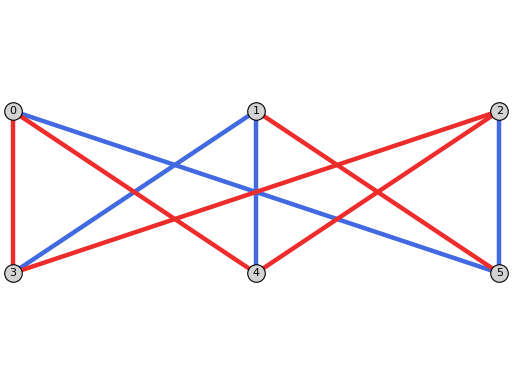
-
is_red(u, v=None)[source]¶ Return if the edge is red.
INPUT:
If
visNone, thenuis consider to be an edge. Otherwise,uvis taken as the edge.EXAMPLES:
sage: from flexrilog import FlexRiGraph sage: G = FlexRiGraph(graphs.CompleteBipartiteGraph(3,3)) sage: delta = G.NAC_colorings()[0] sage: delta.is_red(0,3) True sage: delta.is_red([2,4]) False sage: delta.is_red(1,2) Traceback (most recent call last): ... ValueError: There is no edge [1, 2]
-
is_singleton(NACs=[])[source]¶ Return if the NAC-coloring is a singleton.
Let $G$ be a graph and $N$ be a subset of its NAC-colorings. A NAC-coloring $\delta$ is called singleton w.r.t.$N$ if $|\{(\delta(e),\delta’(e))\colon e\in E_{Q_1}\}|\,\neq 3$ for all $\delta’\in N$.
INPUT:
NACs– being singleton is considered w.r.t the list of NAC-coloringsNACs. If this is empty (default), then all NAC-colorings of the graph are considered.
EXAMPLES:
sage: from flexrilog import GraphGenerator sage: T = GraphGenerator.ThreePrismGraph() sage: delta = T.NAC_colorings()[0] sage: delta.is_singleton() True
sage: Q1 = GraphGenerator.Q1Graph() sage: [[(delta.name(), delta.is_singleton()) for delta in equiv_cls] for equiv_cls in Q1.NAC_colorings_isomorphism_classes()] [[('psi2', False), ('psi1', False)], [('eta', True)], [('gamma1', True), ('gamma2', True)], [('phi4', False), ('phi3', False)], [('epsilon24', True), ('epsilon13', True), ('epsilon23', True), ('epsilon14', True)], [('zeta', False)]]
sage: delta = Q1.name2NAC_coloring('psi1') sage: delta.is_singleton([Q1.name2NAC_coloring(name) for name in ['epsilon23', 'epsilon24', 'epsilon13', 'epsilon14']]) True
-
isomorphic_NAC_coloring(sigma, onlySets=False)[source]¶ Return the NAC-coloring under a morphism
sigma.
-
plot(grid_pos=False, zigzag=False, **args_kwd)[source]¶ Return a plot of the NAC-coloring.
EXAMPLES:
sage: from flexrilog import FlexRiGraph sage: G = FlexRiGraph(graphs.CompleteBipartiteGraph(3,3)) sage: delta = G.NAC_colorings()[0] sage: delta.plot() Graphics object consisting of 16 graphics primitives
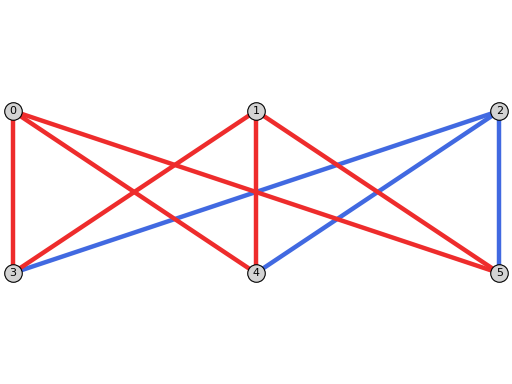
sage: from flexrilog import GraphGenerator sage: G = GraphGenerator.ThreePrismGraph() sage: delta = G.NAC_colorings()[0].conjugated() sage: delta.plot(grid_pos=True) Graphics object consisting of 16 graphics primitives
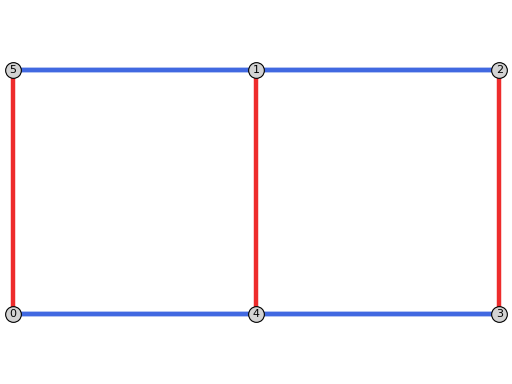
sage: from flexrilog import GraphGenerator sage: G = GraphGenerator.ThreePrismGraph() sage: delta = G.NAC_colorings()[0].conjugated() sage: delta.plot(grid_pos=True, zigzag=True) Graphics object consisting of 16 graphics primitives
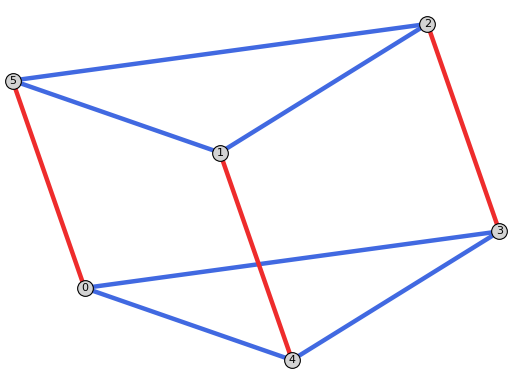
sage: from flexrilog import GraphGenerator sage: G = GraphGenerator.ThreePrismGraph() sage: delta = G.NAC_colorings()[0].conjugated() sage: delta.plot(grid_pos=True, zigzag=[[[0,0], [0,1]], [[0,0], [1,1/2], [2,0]]]) Graphics object consisting of 16 graphics primitives
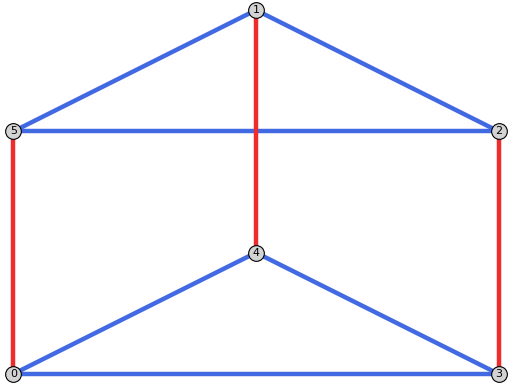
TODO:
doc
-
set_name(new_name)[source]¶ Set a new name.
EXAMPLES:
sage: from flexrilog import GraphGenerator sage: G = GraphGenerator.SmallestFlexibleLamanGraph() sage: delta = G.NAC_colorings()[0]; delta NAC-coloring with red edges [[0, 1], [0, 2], [0, 3], [1, 2], [1, 3]] and blue edges [[2, 4], [3, 4]] sage: delta.set_name('delta'); delta delta: NAC-coloring with red edges [[0, 1], [0, 2], [0, 3], [1, 2], [1, 3]] and blue edges [[2, 4], [3, 4]] sage: latex(delta) \delta: \left( \{\{ 0 , 1 \},\{ 0 , 2 \},\{ 0 , 3 \},\{ 1 , 2 \},\{ 1 , 3 \}\} \mapsto red; \{\{ 2 , 4 \},\{ 3 , 4 \}\} \mapsto blue\right)